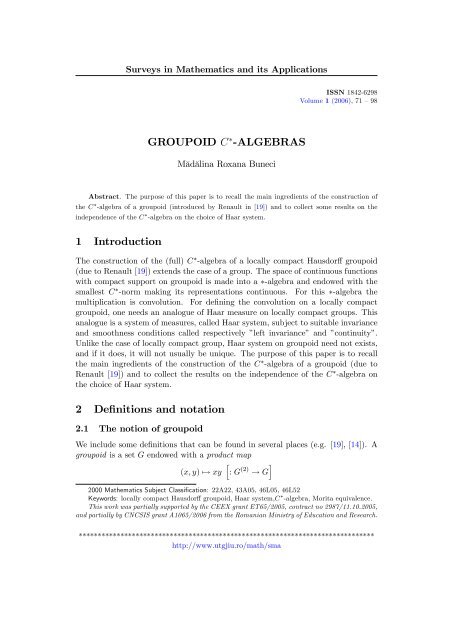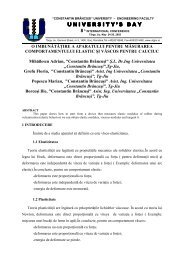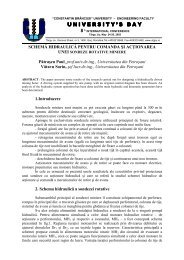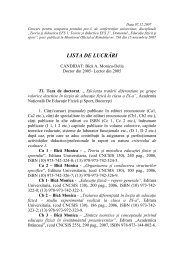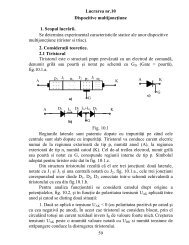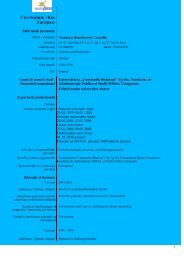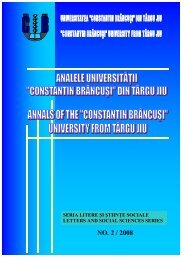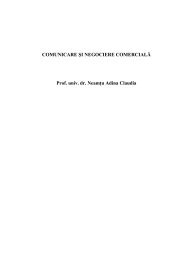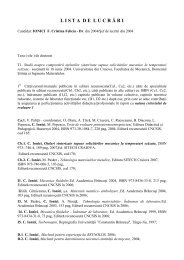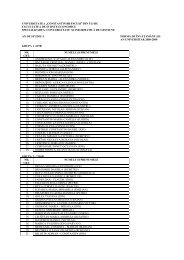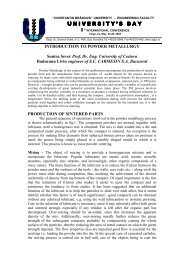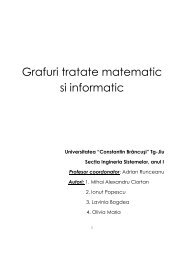GROUPOID C""ALGEBRAS 1 Introduction 2 Definitions and notation
GROUPOID C""ALGEBRAS 1 Introduction 2 Definitions and notation
GROUPOID C""ALGEBRAS 1 Introduction 2 Definitions and notation
You also want an ePaper? Increase the reach of your titles
YUMPU automatically turns print PDFs into web optimized ePapers that Google loves.
Surveys in Mathematics <strong>and</strong> its ApplicationsISSN 1842-6298Volume 1 (2006), 71 –98<strong>GROUPOID</strong> C -<strong>ALGEBRAS</strong>M¼ad¼alina Roxana BuneciAbstract. The purpose of this paper is to recall the main ingredients of the construction ofthe C -algebra of a groupoid (introduced by Renault in [19]) <strong>and</strong> to collect some results on theindependence of the C -algebra on the choice of Haar system.1 <strong>Introduction</strong>The construction of the (full) C -algebra of a locally compact Hausdor¤ groupoid(due to Renault [19]) extends the case of a group. The space of continuous functionswith compact support on groupoid is made into a -algebra <strong>and</strong> endowed with thesmallest C -norm making its representations continuous. For this -algebra themultiplication is convolution. For de…ning the convolution on a locally compactgroupoid, one needs an analogue of Haar measure on locally compact groups. Thisanalogue is a system of measures, called Haar system, subject to suitable invariance<strong>and</strong> smoothness conditions called respectively ”left invariance” <strong>and</strong> ”continuity”.Unlike the case of locally compact group, Haar system on groupoid need not exists,<strong>and</strong> if it does, it will not usually be unique. The purpose of this paper is to recallthe main ingredients of the construction of the C -algebra of a groupoid (due toRenault [19]) <strong>and</strong> to collect the results on the independence of the C -algebra onthe choice of Haar system.2 De…nitions <strong>and</strong> <strong>notation</strong>2.1 The notion of groupoidWe include some de…nitions that can be found in several places (e.g. [19], [14]). Agroupoid is a set G endowed with a product maph i(x; y) 7! xy : G (2) ! G2000 Mathematics Subject Classi…cation: 22A22, 43A05, 46L05, 46L52Keywords: locally compact Hausdor¤ groupoid, Haar system,C -algebra, Morita equivalence.This work was partially supported by the CEEX grant ET65/2005, contract no 2987/11.10.2005,<strong>and</strong> partially by CNCSIS grant A1065/2006 from the Romanian Ministry of Education <strong>and</strong> Research.******************************************************************************http://www.utgjiu.ro/math/sma
Groupoid C -algebras 73A groupoid is said transitive if <strong>and</strong> only if it has a single orbit, or equivalently ifthe map : G ! G (0) G (0) , de…ned by (x) = (r (x) ; d (x)) for all x 2 G,is surjective. Generally, for each orbit [u] of a groupoid G, the reduction of G to[u], Gj [u] , is a transitive groupoid called transitivity component of G. It is easy tosee that (algebraically) G is the disjoint union of its transitivity components. Agroupoid is said principal if the map (de…ned above) is injective.By a homomorphism of groupoids we mean a map ' : G ! (with G,groupoids) satisfying the following condition:if (x; y) 2 G (2) , then ('(x); '(y)) 2It follows that '(x 1 ) = ('(x)) 1 <strong>and</strong> '(G (0) ) (0) .2.2 Borel groupoids <strong>and</strong> topological groupoids(2) <strong>and</strong> '(xy) = '(x)'(y)We shall state some conventions <strong>and</strong> facts about measure theory (see [2], Chapter3).By a Borel space (X; B (X)) we mean a space X, together with a -algebraB (X) of subsets of X, called Borel sets. A subspace of a Borel space (X; B (X)) isa subset S X endowed with the relative Borel structure, namely the -algebra ofall subsets of S of the form S \ E, where E is a Borel subset of X. (X; B (X)) iscalled countably separated if there is a sequence (E n ) nof sets in B (X) separatingthe points of X: i.e., for every pair of distinct points of X there is n 2 N such thatE n contains one point but not both.A function from one Borel space into another is called Borel if the inverse imageof every Borel set is Borel. A one-one onto function Borel in both directions is calledBorel isomorphism.The Borel sets of a topological space are taken to be the -algebra generatedby the open sets. (X; B (X)) is called st<strong>and</strong>ard if it is Borel isomorphic to a Borelsubset of a complete separable metric space. (X; B (X)) is called analytic if it iscountably separated <strong>and</strong> if it is the image of a Borel function from a st<strong>and</strong>ard space.The locally compact Hausdor¤ second countable spaces are analytic.By a measure on a Borel space (X; B (X)) we always mean a map : B (X) !R which satis…es the following conditions:1. is positive ( (A) 0 for all A 2 B (X))2. (;) = 0 1SP3. is countable additive (i.e. A n = 1 (A n ) for all sequences fA n g nn=1 n=1of mutually disjoint sets A n 2 B (X))******************************************************************************Surveys in Mathematics <strong>and</strong> its Applications 1 (2006), 71 –98http://www.utgjiu.ro/math/sma
74 M¼ad¼alina Roxana BuneciLet (X; B (X)) be a Borel space. By a …nite measure on X we mean a measure with (X) < 1 <strong>and</strong> by a probability measure a measure with value 1 on X.We denote by " x the unit point mass at x 2 X, i.e. the probability measure on(X; B (X)) such " x (A) = 1 if x 2 A <strong>and</strong> " x (A) = 0 if x =2 A for any A 2 B (X).The measure is -…nite if there is a sequence fA n g nwith A n 2 B (X) for all n,Ssuch that 1 A n = X <strong>and</strong> (A n ) < 1 for all n. A subset of X or a function on Xn=1is called -measurable (for a -…nite measure ) if it is measurable with respect tothe completion of which is again denoted . The complement of a null set (aset A is null if (A) = 0) is called conull.If (X; B (X)) <strong>and</strong> is a -…nite measure on (X; B (X)), then there is a Borelsubset X 0 of X such that (X X 0 ) = 0 <strong>and</strong> such that X 0 is a st<strong>and</strong>ard spacein its relative Borel structure. Analytic subsets of a countably separated space areuniversally measurable (i.e. -measurable for all …nite measures ).The measures <strong>and</strong> on a Borel space (X; B (X)) are called equivalent measures(<strong>and</strong> we write ) if they have the same null sets (i.e. (A) = 0 i¤ (A) = 0).Every measure class [] = f : g of a -…nite measure 6= 0 contains aprobability measure. If (X; B (X)) <strong>and</strong> (Y; B (Y )) are Borel space, p : X ! Y aBorel function <strong>and</strong> a …nite measure on (X; B (X)), then by p () we denote the…nite measure on (Y; B (Y )) de…ned by p () (A) = p 1 (A) for all A 2 B (Y ),<strong>and</strong> we call it the image of by p. We shall not mention explicitly the Borel setswhen they result from the context (for instance, in the case of a topological spacewe shall always consider the -algebra generated by the open sets).If X is a topological space, then by a Borel measure on X we mean a measurewith the property that (K) < 1 for all compact subsets of X. If X is a topologicalspace which is -compact (i.e. there is sequence fK n g nof compact subsets K n of XSsuch that X = 1 K n ), then any Borel measure on X is -…nite. A measure onn=1X is called regular measure if for each A 2 B (X) (with (A) < 1) <strong>and</strong> each " > 0there are a compact subset K of X <strong>and</strong> an open subset G of X with K A Gsuch that for all sets A 0 2 B (X) with A 0 G K, we have (A 0 ) < ".If X is a locally compact Hausdor¤ space, we denote by C c (X) the space ofcomplex-valuated continuous functions with compact support on X. A Radon measureon X is a linear map L : C c (X) ! E (where E is a Banach space) which iscontinuos with respect to the inductive limit topology on C c (X). If E = C (thespace of complex numbers), then a Radon measure L is called positive if L (f) 0for all f 2 C c (X), f 0. Any linear map L : C c (X) ! C which is positive (i.e.L (f) 0 for all f 2 C c (X), f 0) is in fact a positive Radon measure. Accordingto Riesz-Kakutani Theorem there is a bijective correspondence between the positiveRadon measures on X (i.e. linear positive maps L : C c (X) ! C) <strong>and</strong> the Borelregular (positive) measures on X (the bijection is given by L (f) = R f (x) d (x) forall real function f 2 C c (X); in the sequel we shall identify L with ).******************************************************************************Surveys in Mathematics <strong>and</strong> its Applications 1 (2006), 71 –98http://www.utgjiu.ro/math/sma
Groupoid C -algebras 77with X. Two extreme cases deserve to be single out. If E = X X, then Eis called the trivial groupoid on X, while if E = diag (X), then E is called theco-trivial groupoid on X (<strong>and</strong> may be identi…ed with the groupoid in example3).If G is any groupoid, thenR = f(r (x) ; d (x)) ; x 2 Ggis an equivalence relation on G (0) . The groupoid de…ned by this equivalencerelation is called the principal groupoid associated with G.Any locally compact principal groupoid can be viewed as an equivalence relationon a locally compact space X having its graph E X X endowedwith a locally compact topology compatible with the groupoid structure. Thistopology can be …ner than the product topology induced from X X. We shallendow the principal groupoid associated with a groupoid G with the quotienttopology induced from G by the map : G ! R; (x) = (r (x) ; d (x))This topology consists of the sets whose inverse images by in G are open.2.4 Haar systemsFor developing an algebraic theory of functions on a locally compact groupoid, oneneeds an analogue of Haar measure on locally compact groups. Several generalizationsof the Haar measure to the setting of groupoids were taken into considerationsin the literature (see [27], [23], [10], [9], [19]). We use the de…nition adopted byRenault in [19]. The analogue of Haar measure in the setting of groupoids is a systemof measures, called Haar system, subject to suitable invariance <strong>and</strong> smoothnessconditions called respectively "left invariance" <strong>and</strong> "continuity". More precisely, a(left) Haar system on a locally compact Hausdor¤ groupoid G is a family of positiveRadon measures (or equivalently, Borel regular measures) on G, = u ; u 2 G (0) ,such that1) For all u 2 G (0) , supp( u ) = G u .2) For all f 2 C c (G),Zu 7!f (x) d u (x)h i: G (0) ! Cis continuous.3) For all f 2 C c (G) <strong>and</strong> all x 2 G,Zf (y) d r(x) (y) =Zf (xy) d d(x) (y)******************************************************************************Surveys in Mathematics <strong>and</strong> its Applications 1 (2006), 71 –98http://www.utgjiu.ro/math/sma
78 M¼ad¼alina Roxana BuneciUnlike the case for locally compact groups, Haar systems on groupoids need notexist. Also, when a Haar system does exist, it need not be unique. The continuityassumption 2) has topological consequences for G. It entails that the range mapr : G ! G (0) , <strong>and</strong> hence the domain map d : G ! G (0) is an open (PropositionI.4 [26]. We shall see later that (according to a result of Seda [25]) the continuityassumption 2) is essential for construction of the C -algebra of G in the sense ofRenault [19].A. K. Seda has established su¢ cient conditions for the existence of Haar systems.He has proved that if a locally compact Hausdor¤ groupoid G is locally transitive,then the continuity assumption 2) follows from the left invariance assumption 3)(Theorem 2/p. 430 [24]). Thus he has proved that locally transitive locally compactHausdor¤ groupoids admit Haar system. At the opposite case of totally intransitivegroupoids, Renault has established necessary <strong>and</strong> su¢ cient conditions. More precisely,Renault has proved that a locally compact Hausdor¤ groupoid G which is agroup bundle (a groupoid with the property that r (x) = d (x) for all x) admits aHaar system if <strong>and</strong> only if r is open (Lemma 1.3/p. 6 [20]). In [5] we have considereda locally compact Hausdor¤ groupoid G having paracompact unit space <strong>and</strong>a family of positive Radon measures on G, u ; u 2 G (0) , satisfying condition 1)<strong>and</strong> 3) in the de…nition of Haar system <strong>and</strong> for each f 2 C c (G) we have denoted byF f : G ! R the map de…ned byZZF f (x) = f (y) d d(x) (y) f (y) d r(x) (y) (8) x 2 GWe have established that F f is a groupoid homomorphism continuous at everyunit u 2 G (0) . We also proved that if G has open range map, if F f is continuouson G for all f 2 C c (G) <strong>and</strong> if there is a function h : G ! [0; 1], universally measurableon each transitivity component Gj [u] , with u (h) = 1 for all u 2 G (0) , then u ; u 2 G (0) is a Haar system (Theorem 4 [5]).This result generalizes Lemma 1.3[20] (for group bundle F f = 0) <strong>and</strong> Theorem 2/page 430 [24] (for locally transitivelocally compact Hausdor¤ groupoids, if a groupoid homomorphism F is continuousat every unit, then F is continuous everywhere).Also for the case of r-discrete groupoids Renault has established necessary <strong>and</strong>su¢ cient conditions for the existence of Haar systems. If G is an r-discrete groupoid,then G admits a Haar system if <strong>and</strong> only if r (<strong>and</strong> hence d) is a local homeomorphism.A Haar system on an r-discrete groupoid is essentially the counting measuressystem -each measure in the Haar system is multiple of counting measure on thecorresponding …ber. (Lemma I.2.7/p. 18 <strong>and</strong> Proposition I.2.8/p. 19 [19]).If = u ; u 2 G (0) is a (left) Haar system on G, then for each u 2 G (0) wedenote by u the image of u by the inverse map x ! x 1 :ZZf (x) d u (x) = f x 1 d (x) , for all f 2 C c (G)******************************************************************************Surveys in Mathematics <strong>and</strong> its Applications 1 (2006), 71 –98http://www.utgjiu.ro/math/sma
Groupoid C -algebras 79Then u ; u 2 G (0) is a right Haar system on G, that is a family of positiveRadon measures on G such that1) For all u 2 G (0) , supp( u ) = G u .2) For all f 2 C c (G),Zh iu 7! f (x) d u (x) : G (0) ! Cis continuous.3) For all f 2 C c (G) <strong>and</strong> all x 2 G,Zf (y) d d(x) (y) =Zf (yx) d r(x) (y)We shall work only with left Haar systems.Examples1. If G is locally compact Hausdor¤ group, then G (as a groupoid) admits anessentially unique (left) Haar system fg where is a Haar measure on G.2. If is a locally compact Hausdor¤ group acting continuous on a locally compactHausdor¤ space X, then X (as a groupoid) admits a distinguished(left) Haar system f" x ; x 2 Xg where is a Haar measure on <strong>and</strong> " x isthe unit point mass at x.3. If X is a locally compact Hausdor¤ space <strong>and</strong> if is a positive Radon measureon X with full support (i.e.supp () = X), then f" x ; x 2 Xg is a Haarsystem on X X (as a trivial groupoid) where " x is the unit point mass atx. Conversely, any Haar system on X X may be written in this form (fora positive Radon measure ).4. If X is a locally compact Hausdor¤ space, then f" x ; x 2 Xg is a Haar systemon X (as a co-trivial groupoid, Examples 3 Subsection 2.3).Let = u ; u 2 G (0) be a Haar system on a locally compact Hausdor¤groupoid G.If is a positive Radon measure on G (0) , then the measure = R u d (u),de…ned byZZ Zf (y) d (y) = f (y) d u (y) d (u) , f 2 C c (G)is called the measure on G induced by . The image of by the inverse mapx ! x 1 is denoted ( ) 1 . The measure is said to be quasi-invariant (withrespect to ) if its induced measure is equivalent to its inverse, ( ) 1 . A measure******************************************************************************Surveys in Mathematics <strong>and</strong> its Applications 1 (2006), 71 –98http://www.utgjiu.ro/math/sma
86 M¼ad¼alina Roxana Buneci2.3). The convolution of f, g 2 C c (X ) is given by:Zf g (x; ) = f (x; ) y; 0 g y; 0 1d (" x ) y; 0Z= f x; 0 g x 0 ; 0 1 d 0Z= f x; 0 g x 0 ; 0 1 d 0<strong>and</strong> the involution byf (x; ) = f (x; 1 ).3. If X is a locally compact Hausdor¤ space <strong>and</strong> if is a positive Radon measureon X with full support (i.e.supp () = X), then f" x ; x 2 Xg is a Haarsystem on X X (as a trivial groupoid). The convolution of f, g 2 C c (X X)is given by:f g (x; y) ==ZZf ((x; y) (t; z)) g (t; z) 1 d (" y ) (t; z)f (x; z) g (z; y) d (z)<strong>and</strong> the involution byf (x; y) = f (y; x).4. If X is a locally compact Hausdor¤ space, then f" x ; x 2 Xg is a Haar systemon X (seen as a co-trivial groupoid identi…ed with the groupoid described inExamples 3 Subsection 2.3). The convolution of f, g 2 C c (G) is given by:Zf g (x) = f (xy) g y 1 d" x (y)= f (xx) g x 1= f (x) g (x)<strong>and</strong> the involution byf (x) = f (x).Let = u ; u 2 G (0) be a Haar system on the locally compact Hausdor¤groupoid G. A representation of C c (G; ) is a -homomorphism L from the topological-algebra C c (G,) into B (H), for some Hilbert space H, that is continuouswith respect to the inductive limit topology on C c (G) <strong>and</strong> the weak operator topologyon B (H). The representation L is said non-degenerate if the linear span offL (g) : g 2 C c ( ) ; 2 Hg******************************************************************************Surveys in Mathematics <strong>and</strong> its Applications 1 (2006), 71 –98http://www.utgjiu.ro/math/sma
Groupoid C -algebras 891. ( x) = r () for all (; x) 2 X.2. (x) x = x for all x 2 X.3. If ( 2 ; 1 ) 2 (2) <strong>and</strong> ( 1 ; x) 2 X, then ( 2 1 ) x = 2 ( 1 x).If is a topological groupoid <strong>and</strong> X is a topological space, then we say that a leftaction is continuous if the map is continuous <strong>and</strong> open <strong>and</strong> the map (; x) 7! xis continuous, where X is endowed with the relative product topology comingfrom X.The action is called free if (; x) 2 X <strong>and</strong> x = x implies 2 (0) .The continuous action is called proper if the map (; x) 7! ( x; x) from Xto X X is proper (i.e. the inverse image of each compact subset of X X is acompact subset of X).In the same manner, we de…ne a right action of on X, using a continuous map : X !(0) <strong>and</strong> a map (x; ) 7! x fromX = f(x; ) : (x) = r () gto X.The simplest example of proper <strong>and</strong> free action is the case when the locallycompact Hausdor¤ groupoid acts upon itself by either right or left translation(multiplication).De…nition 3. Let 1; 2 be two groupoids <strong>and</strong> X be set. Let us assume that 1 actsto the left on X with momentum map : X ! (0)1 , <strong>and</strong> that 2 acts to the right onX with momentum map : X ! (0)2 . We say that the actions commute if1. (x 2 ) = (x) for all (x; 2 ) 2 X 2 <strong>and</strong> ( 1 x) = (x) for all ( 1 ; x) 21 X:2. 1 (x 2 ) = ( 1 x) 2 for all ( 1 ; x) 2 1 X, (x; 2 ) 2 X 2 .De…nition 4. Let 1; 2 be two locally compact Hausdor¤ groupoids having openrange maps. The locally compact Hausdor¤ space X is said a ( 1 ; 2)-Moritaequivalence if the following conditions are satis…ed:1. 1 acts to the left on X with momentum map : X ! (0)1 <strong>and</strong> the action iscontinuous free <strong>and</strong> proper.2. 2 acts to the right on X with momentum map : X ! (0)2 <strong>and</strong> <strong>and</strong> theaction is continuous free <strong>and</strong> proper3. The actions commute.******************************************************************************Surveys in Mathematics <strong>and</strong> its Applications 1 (2006), 71 –98http://www.utgjiu.ro/math/sma
90 M¼ad¼alina Roxana Buneci4. If (s) = (t), then there is x 2 2 such that s x = t.5. If (s) = (t), then there is 2 1 such that s = t.The groupoids 1; 2 are called Morita equivalent.The notion of Morita equivalence de…ned above is an equivalence relation onlocally compact Hausdor¤ groupoids having open range maps (see [13]).Examples1. Any locally compact groupoid having open range map is a ( ; )-Moritaequivalence (Examples 5.33.1 [14])2. If 1, 2 are locally compact Hausdor¤ groupoids having open range maps,' : 1 ! 2 is an isomorphism <strong>and</strong> if ' is a homeomorphism then 1 is a( 1 ; 2)-Morita equivalence ( 1 acts to the left on 1 by multiplication <strong>and</strong> 2acts to the right on 1 by y x = y' (x))(Examples 5.33.2 [14]).3. If G is a locally compact Hausdor¤ transitive groupoid which is second countable<strong>and</strong> u is a unit in G (0) then G u is a (G; G u u)-Morita equivalence (Theorem2.2A, Theorem 2.2B [13]). More generally, if is a locally compact Hausdor¤groupoid, F is a closed subset of (0) <strong>and</strong> if the restrictions of r <strong>and</strong> d to Fare open, then F is a ( ; j F )-Morita equivalence.4. If R is an equivalence relation on a locally compact Hausdor¤ space X, suchthat R as a subset of X X is a closed set, then X implements a Moritaequivalence between the groupoid R (see 5 in Subsection 2.3), <strong>and</strong> the groupoidX=R (see 2 in Subsection 2.3) (Examples 5.33.5 [14]).De…nition 5. Let A be a C -algebra. A pre-Hilbert A-module is a right A-moduleX (with a compatible C-vector space structure) equipped with a conjugate-bilinearmap (liner in the second variable) h; i A : X X ! A satisfying:1. hx; y ai A= hx; yi A a for all x; y 2 X, a 2 A.2. hx; yi A = hy; xi Afor all x; y 2 X.3. hx; xi A 0 for all x 2 X.4. hx; xi A= 0 only when x = 0.The map h; i Ais called A-valued inner product on X:A left pre-Hilbert A-module is de…ned in the same way, except that X is requiredto be a left A-module, the map A h; i : X X ! A is required to be linear in the…rst variable, <strong>and</strong> the …rst condition above is replaced by A ha x; yi = a A hx; yifor all x; y 2 X, a 2 A ([15], [21]).******************************************************************************Surveys in Mathematics <strong>and</strong> its Applications 1 (2006), 71 –98http://www.utgjiu.ro/math/sma
Groupoid C -algebras 91It can be shown that kxk = khx; xik 1 2 de…nes a norm on X. If X is completewith respect to this norm, it is called a Hilbert A-module. If not, all the structurecan be extended to its completion to turn it into a Hilbert A-module.As a normed linear space, a right Hilbert A-module X carries an algebra ofbounded linear transformations. In the following we shall denote by B (X) thecollection of all bounded linear maps T : X ! X which are module maps (this meansthat T (x a) = T (x)a for all x 2 X, a 2 A) <strong>and</strong> adjointable (this means that thereis another linear bounded operator T on X such that hT (x) ; yi A= hx; T (y)i Aforall x; y 2 X). It is easy to see that if X is Hilbert space <strong>and</strong> A = C (the space ofcomplex numbers), then B (X) is the algebra of linear bounded operators on X. Thealgebra of linear bounded operators on a Hilbert X has a two-sided closed non-trivialideal K (X) (the compact operators). The analog of that ideal of compact operatorsis given in the case of a right Hilbert A-module X by the closed linear span in B (X)of all the "rank one" transformations on X, i.e. of all transformations of the formx y : X ! X de…ned by x y (z) = x hy; zi Afor all z 2 X, with x; y 2 X. Theclosed linear span in B (X) of all transformations xy (with x; y 2 X) is denoted byK (X), it is called the imprimitivity algebra of X <strong>and</strong> its elements are called compactoperators on X. If X is a left Hilbert A-module, then imprimitivity algebra K (X)is the closed linear span of all transformations of the form x y : X ! X de…nedby x y (z) = A hz; yi x for all z 2 X, with x; y 2 X.Proposition 6. If A is a C -algebra <strong>and</strong> if X is a right Hilbert A-module, then B (X)<strong>and</strong> K (X) are C -algebras, with B (X) equal to the multiplier algebra of K (X).Further, X becomes a left Hilbert C -module over K (X), where the K (X)-valuedinner product is de…ned by the formula:K(X) hx; yi = x y , for all x; y 2 X,<strong>and</strong> K (X) (X as a left Hilbert C -module over K (X)) is naturally isomorphic to Athough the formulax y ! hx; yi A.De…nition 7. Let A <strong>and</strong> B be C -algebras. By an (A; B)-equivalence bimodule wemean an A, B -bimodule X equipped with A <strong>and</strong> B-valued inner products with respectto which X is a right Hilbert B-module <strong>and</strong> a left Hilbert A-module such that:1. A hx; yi z = x hy; zi Bfor all x; y; z 2 X.2. hax; axi B kak 2 hx; xi Bfor all a 2 A, x 2 X <strong>and</strong> A hxb; xbi kbk 2 Ahx; xi forall b 2 B, x 2 X.3. hX; Xi Bspans a dense subset of B <strong>and</strong> A hX; Xi spans a dense subset of A.******************************************************************************Surveys in Mathematics <strong>and</strong> its Applications 1 (2006), 71 –98http://www.utgjiu.ro/math/sma
92 M¼ad¼alina Roxana BuneciWe call A <strong>and</strong> B strongly Morita equivalent if there is an (A; B)-equivalencebimodule.Strong Morita equivalence is an equivalence relation.If A is a C -algebra <strong>and</strong> if X is a Hilbert A-module, then A <strong>and</strong> K (X) arestrongly Morita equivalence.Proposition 8. Let A <strong>and</strong> B be C -algebras <strong>and</strong> X be an (A; B)-equivalence bimodule.Then the map from K (X) (X as a right Hilbert C -module over B) to Ade…ned by formulaAx y 7! hx; yiis a C -isomorphism. Similarly, the map from K (X) (X as a left Hilbert C -moduleover A) to A de…ned by formulais a C -isomorphism.x y 7! hx; yi BThus, two C -algebras are strongly Morita equivalent if <strong>and</strong> only if one can berealized as compact operators of a Hilbert C -module over the other.Theorem 9. If A <strong>and</strong> B are two stably isomorphic C -algebras (in the sense thatA K is isomorphic to B K, where K is the algebra of compact operators on aseparable Hilbert space), then A <strong>and</strong> B are strongly Morita equivalent. Conversely, ifA <strong>and</strong> B have countable approximate identities, <strong>and</strong> if A <strong>and</strong> B are strongly Moritaequivalent, then A <strong>and</strong> B are stably isomorphic. ([3])Using the correspondence of groupoid representations <strong>and</strong> representations of C -algebra, Muhly, Renault <strong>and</strong> Williams proved the following theorem:Theorem 10. Let <strong>and</strong> G be locally compact, second countable, Hausdor¤ groupoidsendowed with the Haar systems <strong>and</strong> , respectively. If <strong>and</strong> G are Morita equivalent,then C ( ; ) <strong>and</strong> C (G; ) are strongly Morita equivalent. (Theorem 2.8/p.10 [13]).5 Results concerning the independence of the groupoidC -algebra of the Haar systemThe de…nition of the groupoid C -algebra depends on the choice of the Haar system(the convolution is de…ned using a Haar system). In the group case, Haar measure isessentially unique, but for groupoids, this is no longer the case. Due to Theorem 10,di¤erent choices of Haar system produces strongly Morita equivalent C -algebras.This still leaves open the question: are the C -algebras associated with two Haarsystems -isomorphic. As Muhly, Renault <strong>and</strong> Williams proved, this is indeed thecase for transitive groupoid:******************************************************************************Surveys in Mathematics <strong>and</strong> its Applications 1 (2006), 71 –98http://www.utgjiu.ro/math/sma
Groupoid C -algebras 93Theorem 11. If the locally compact, second countable, Hausdor¤ groupoid G istransitive, then the (full) C -algebra of G is isomorphic to C (H) K L 2 () ,where H is the isotropy group G e e at any unit e 2 G (0) , is an essentially uniquemeasure on G (0) , C (H) denotes the group C -algebra of H, <strong>and</strong> K L 2 () denotesthe compact operators on L 2 (). (Theorem 3.1/p.16 [13, Theorem 3.1, p. 16]).Consequently, the (full) C -algebras of a transitive locally compact, secondcountable, Hausdor¤ groupoid G associated with two Haar systems are -isomorphic.In order to prove that result Muhly, Renault <strong>and</strong> Williams …rstly established thatC (G) <strong>and</strong> C (H) are strong Morita equivalent via a (C (H) ; C (G)) -equivalencebimodule module X 1 (because G <strong>and</strong> H are Morita equivalent groupoids). As aconsequence the C -algebra of G is the imprimitivity algebra of X 1 . Then theyneeded another C (H) module X 2 (isomorphic to X 1 ) whose imprimitivity algebrais C (H) K L 2 () for a suitable measure .We can obtain the isomorphism between the C -algebra of G <strong>and</strong> C (H) K L 2 () more directly. If we endow G (0) H G (0) with the product topology,<strong>and</strong> the operations(u; x; v) (v; y; w) = (u; xy; w)(u; x; v) 1 = (v; x; u)then it becomes a locally compact second countable groupoid. The system of measures " u e ; u 2 G (0) , where " u is the unit point mass at u, e is the Haarmeasure on H = G e e <strong>and</strong> is a measure of full support on G (0) , is Haar system onG (0) HG (0) . It is not hard to prove that the C -algebra of G (0) HG (0) endowedwith the Haar system " u e ; u 2 G (0) is -isomorphic to C (H)K L 2 () .On the other h<strong>and</strong> since G is a locally compact, second countable, Hausdor¤ transitivegroupoid, the restriction of the domain map to G e is an open map (see [13]).According to Mackey Lemma (Lemma 1.1 [12]), there is : G (0) ! G e a regularBorel cross section of d : G e ! G (0) . This means that d ( (u)) = u for allu 2 G (0) <strong>and</strong> (K) has compact closure in G e for each compact set K in G (0) . Then : G ! G (0) H G (0) de…ned by (x) = r (x) ; (r (x)) x (d (x)) 1 ; d (x)is a Borel isomorphism which carries the Haar system of G into a Haar system ofG (0) H G (0) of the form " u e ; u 2 G (0) , where " u is the unit point massat u 2 G (0) , e is a Haar measure on H = G e e, <strong>and</strong> is a suitable Radon measureon G (0) with full support:Proposition 12. Let G be a locally compact second countable transitive groupoid.Let e be a unit <strong>and</strong> : G (0) ! G e be a regular Borel cross section of d : G e ! G (0) .Then : G ! G (0) G e e G (0) de…ned by (x) = r (x) ; (r (x)) x (d (x)) 1 ; d (x)******************************************************************************Surveys in Mathematics <strong>and</strong> its Applications 1 (2006), 71 –98http://www.utgjiu.ro/math/sma
94 M¼ad¼alina Roxana Buneciis a Borel isomorphism which carries Haar system of G into a Haar system ofG (0) G e e G (0) of the form " u e ; u 2 G (0) , where " u is the unit pointmass at u 2 G (0) , e is a Haar measure on G e e, <strong>and</strong> is a suitable Radon measureon G (0) .Using the fact that any compactly supported Borel bounded function on a transitivegroupoid can be viewed as an element of the groupoid C - algebra (Proposition4/p. 82, Proposition 5/p. 86 [4]) <strong>and</strong> we can prove that the f 7! f extends to a-isomorphism from C G (0) H G (0) to C (G). Thus C (G) is -isomorphicto C (H) K L 2 () .A locally compact groupoid G is proper if the map (r; d) : G ! G (0) G (0) isproper (i.e. the inverse map of each compact subset of G (0) G (0) is compact). [1,De…nition 2.1.9]. In the sequel by a groupoid with proper orbit space we shall meana groupoid G for which the orbit space is Hausdor¤ <strong>and</strong> the map(r; d) : G ! R; (r; d) (x) = (r (x) ; d (x))is open, where R is endowed with the product topology induced from G (0) G (0) .Applying Lemma 1.1 of [12] to the locally compact second countable spaces G (0)<strong>and</strong> G (0) =G <strong>and</strong> to the continuous open surjection : G (0) ! G (0) =G, it follows thatthere is a Borel set F in G (0) such that:1. F contains exactly one element in each orbit [u] = 1 ( (u)).2. For each compact subset K of G (0) , F \ [K] = F \ 1 ( (K)) has a compactclosure.For each unit u let us de…ne e (u) to be the unique element in the orbit of u that iscontained in F , i.e. fe (u)g = F \[u]. For each Borel subset B of G (0) , is continuous<strong>and</strong> one-to-one on B \ F <strong>and</strong> hence (B \ F ) is Borel in G (0) =G. Therefore themap e : G (0) ! G (0) is Borel (for each Borel subset B of G (0) , e 1 (B) = [B \ F ] = 1 ( (B \ F )) is Borel in G (0) ). Also for each compact subset K of G (0) , e (K) hasa compact closure because e (K) F \ [K].Since the orbit space G (0) =G is proper the map(r; d) : G ! R; (r; d) (x) = (r (x) ; d (x))is open <strong>and</strong> R is closed in G (0) G (0) . Applying Lemma 1.1 of [12] to the locallycompact second countable spaces G <strong>and</strong> R <strong>and</strong> to the continuous open surjection(r; d) : G ! R, it follows that there is a regular cross section 0 : R ! G. Thismeans that 0 is Borel, (r; d) ( 0 (u; v)) = (u; v) for all (u; v) 2 R, <strong>and</strong> 0 (K) isrelatively compact in G for each compact subset K of R.Let us de…ne : G (0) ! G F by (u) = 0 (e (u) ; u) for all u. It is easy to notethat is a cross section for d : G F ! G (0) <strong>and</strong> (K) is relatively compact in G forall compact K G (0) . If F is closed, then is regular.******************************************************************************Surveys in Mathematics <strong>and</strong> its Applications 1 (2006), 71 –98http://www.utgjiu.ro/math/sma
Groupoid C -algebras 95Replacing byv 7! (e (v)) 1 (v)we may assume that (e (v)) = e (v) for all v. Let us de…ne q : G ! G F F byq (x) = (r (x)) x (d (x)) 1 ; x 2 G.Let = u : u 2 G (0) be a Haar system on G <strong>and</strong> let f u vg ; _u be itsdecompositions over the principal groupoid . Let be the 1-cocycle associated tothe decomposition.Let us denote by B (G) the linear span of the functions of the formx 7! g 1 (r (x)) g (q (x)) g 2 (d (x))where g 1 ; g 2 are compactly supported bounded Borel functions on G (0) <strong>and</strong> g is abounded Borel function on G F Fsuch that if S is the support of g, then the closure ofS is compact in G. B (G) is a subspace of B c (G), the space of compactly supportedbounded Borel functions on G.If f 1 , f 2 2 B (G) are de…ned bythenf 1 (x) = g 1 (r (x)) g (q (x)) g 2 (d (x))f 2 (x) = h 1 (r (x)) h (q (x)) h 2 (d (x))f 1 f 2 (x) = g h (q (x)) g 1 (r (x)) h 2 (d (x)) g 2 ; h 1(r(x))f1 (x) = g 2 (r (x))g q (x) 1 g 1 (d (x))Thus B (G) is closed under convolution <strong>and</strong> involution.Let ! be the universal representation of C (G; ) the usual (full) C -algebraassociated to a Haar system = u ; u 2 G (0) . Since every cyclic representationof C (G; ) is the integrated form of a representation of G, it follows that ! canbe also regarded as a representation of B c (G), the space of compactly supportedbounded Borel functions on G. Arlan Ramsay <strong>and</strong> Martin E. Walter have usedthe <strong>notation</strong> M (G; ) for the operator norm closure of ! (B c (G)). Since ! is an-isomorphism on C (G; ), we can regarded C (G; ) as a subalgebra of M (G; ).In [7] we denoted by M (G; ) the operator norm closure of ! (B (G)).Theorem 13. Let G be a locally compact second countable groupoid with proper orbitspace. Let u i ; u 2 G(0) , i = 1; 2 be two Haar systems on G. Let F be a Borelsubset of G (0) containing only one element e (u) in each orbit [u]. Let : G (0) ! G Fbe a cross section for d : G F ! G (0) with (e (v)) = e (v) for all v 2 G (0) <strong>and</strong> suchthat (K) is relatively compact in G for all compact K G (0) . Then the C -algebrasM (G; 1 ) <strong>and</strong> M (G; 2 ) are -isomorphic (Theorem 9 [7]).******************************************************************************Surveys in Mathematics <strong>and</strong> its Applications 1 (2006), 71 –98http://www.utgjiu.ro/math/sma
96 M¼ad¼alina Roxana BuneciTheorem 14. Let G be a locally compact second countable groupoid with properorbit space. Let u ; u 2 G (0) be a Haar systems on G. Let F i , i = 1; 2, be twoBorel subsets of G (0) containing only one element e i (u) in each orbit [u]. For eachi = 1; 2, let i : G (0) ! G F ibe a cross section for d Fi : G F i! G (0) , d Fi (x) = d (x),satisfying the conditions1. i (e i (v)) = e i (v) for all v 2 G (0)2. i (K) is relatively compact in G for all compact sets K G (0) .Then the C -algebras M 1(G; ) <strong>and</strong> M 2(G; ) are -isomorphic. (Theorem 6[8]).Thus M (G; ) is a C -algebra which does not depend on the choice of the Haarsystem <strong>and</strong> also does not depend on the choice of cross section .Theorem 15. Let G be a locally compact second countable locally transitive groupoidendowed with a Haar system u ; u 2 G (0) . Let F be a subset of G (0) containingonly one element e (u) in each orbit [u]. Let : G (0) ! G F be a regular cross sectionof d F . ThenC (G; ) = M (G; ) = M (G; ) .(Proposition 18 [7])Theorem 16. Let G be a locally compact second countable principal proper groupoid.Let F be a Borel subset of G (0) meeting each orbit exactly once. Let : G (0) ! G Fbe a cross section for d : G F ! G such that (K) is relatively compact in G for allcompact K G (0) . Let u ; u 2 G (0) be a Haar system on G. Then(Corollary 23 [7]).ReferencesC (G; ) M (G; ) M (G; ) .[1] C. Anantharaman-Delaroche, J. Renault, Amenable groupoids, Monographiede L’Enseignement Mathematique No 36, Geneve, 2000.MR1799683(2001m:22005). Zbl 0960.43003.[2] W. Arveson, An invitation to C -algebras, Springer-Verlag, New York, 1976.MR0512360(58 #23621). Zbl 0344.46123.[3] L.G. Brown, P. Green, M. Rie¤el, Stable isomorphism <strong>and</strong> strong Moritaequivalence of C -algebras, Paci…c J. Math. 71(1977), 349-363. MR0463928(57#3866). Zbl 0362.46043.******************************************************************************Surveys in Mathematics <strong>and</strong> its Applications 1 (2006), 71 –98http://www.utgjiu.ro/math/sma
Groupoid C -algebras 97[4] M. Buneci, C -algebras associated to the transitive groupoids, An. Univ. CraiovaSer. Mat. Inform. 28 (2001), 79–92. MR1902038(2003b:46085).Zbl 1069.46510.[5] M. Buneci, Haar systems <strong>and</strong> homomorphism on groupoids, Operator algebras<strong>and</strong> mathematical physics (Constanta, 2001), 35–49, Theta, Bucharest, 2003.MR2018222(2004j:22006).[6] M. Buneci, The structure of the Haar systems on locally compactgroupoids, Math. Phys. Electron. J. 8 (2002) Paper 4, 11 pp. (electronic).MR1978500(2004c:46102). Zbl 1023.46057.[7] M. Buneci, Isomorphic groupoid C -algebras associated with di¤erent Haar systems,New York J. Math. 11 (2005), 225-245. MR2154355. Zbl 1091.43001.[8] M. Buneci , C -algebras associated to groupoids with proper orbit space, OperatorTheory 20 (Timisoara, 2004), 45-53.Theta Ser. Adv. Math., 6, Theta,Bucharest, 2006.[9] A. Connes, Sur la theorie noncommutative de l’integration, Lecture Notes inMath. Springer-Verlag, Berlin 725 (1979) 19-143. MR0548112(81g:46090). Zbl0412.46053.[10] P. Hahn, Haar measure for measure groupoids, Trans. Amer. Math. Soc. 242(1978), 1-33. MR0496796(82a:28012). Zbl 0343.43003.[11] P. Hahn, The regular representations of measure groupoids, Trans. Amer. Math.Soc. 242 (1978), 34-72. MR0496797(81f:46075). Zbl 0356.46055.[12] G. Mackey, Induced representations of locally compact groups. I, Ann. of Math.,55 (1952), 101-139. MR0044536(13,434a). Zbl 0046.11601.[13] P. Muhly, J. Renault <strong>and</strong> D. Williams, Equivalence <strong>and</strong> isomorphismfor groupoid C*-algebras, J. Operator Theory 17 (1987), 3-22.MR0873460(88h:46123). Zbl 0645.46040.[14] P. Muhly, Coordinates in operator algebra, (Book in preparation).[15] W. Paschke, Inner product modules over B -algebras, Trans. Amer. Math. Soc.182 (1973), 443-468. MR0355613(50 #8087). Zbl 0239.46062.[16] A. Ramsay, Virtual groups <strong>and</strong> groups actions, Adv. in Math. 6 (1971), 253-322.MR0281876(43 #7590). Zbl 0216.14902.[17] A. Ramsay, Topologies on measured groupoids, J. Funct. Anal. 47 (1982), 314-343. MR0665021(83k:22014). Zbl 0519.22003.******************************************************************************Surveys in Mathematics <strong>and</strong> its Applications 1 (2006), 71 –98http://www.utgjiu.ro/math/sma
98 M¼ad¼alina Roxana Buneci[18] A. Ramsay <strong>and</strong> M. E. Walter, Fourier-Stieltjes Algebras of locally compactgroupoids, J. Funct. Anal. 148 (1997), 314-367. MR1469344(99a:22010). Zbl0901.43002.[19] J. Renault, A groupoid approach to C - algebras, Lecture Notes in Math.,Springer-Verlag, 793, 1980. MR0584266(82h:46075). Zbl 0433.46049.[20] J. Renault,The ideal structure of groupoid crossed product algebras, J. OperatorTheory, 25 (1991), 3-36. MR1191252(94g:46074). Zbl 0786.46050.[21] M. Rie¤el, Induced representations of C -algebras, Adv. in Math. 13(1974),176-254. MR0353003(50 #5489). Zbl 0284.46040.[22] M. Rie¤el, Strong Morita equivalence of certain transformation group C -algebras, Math. Ann. 222 (1976), 7-22. MR0419677(54 #7695). Zbl 0328.22013.[23] A. K. Seda, A continuity property of Haar systems of measures, Ann. Soc. Sci.Bruxelles 89 IV (1975), 429-433. MR0402741(53 #6555). Zbl 0313.28018.[24] A.K. Seda, Haar measures for groupoids, Proc. Royal Irish Acad. 76, Sec. A,no. 5, (1976), 25-36. MR0427598(55 #629). Zbl 0329.43002.[25] A.K. Seda, On the continuity of Haar measure on topological groupoids,Proc. Amer. Math. Soc., 96 (1986), 115-120. MR0813822(87m:46146). Zbl0593.28015.[26] J. Westman, Nontransitive groupoid algebras, Univ. of California at Irvine, 1967.[27] J. Westman, Harmonic analysis on groupoids, Paci…c J. Math. 27 (1968), 621-632. MR0244443(39 #5758). Zbl 0167.44003.University Constantin Brâncuşi of Târgu-Jiu,Bld. Republicii 1, 210152, Târgu-Jiu,Romania.e-mail: ada@utgjiu.rohttp://www.utgjiu.ro/math/mbuneci/******************************************************************************Surveys in Mathematics <strong>and</strong> its Applications 1 (2006), 71 –98http://www.utgjiu.ro/math/sma


